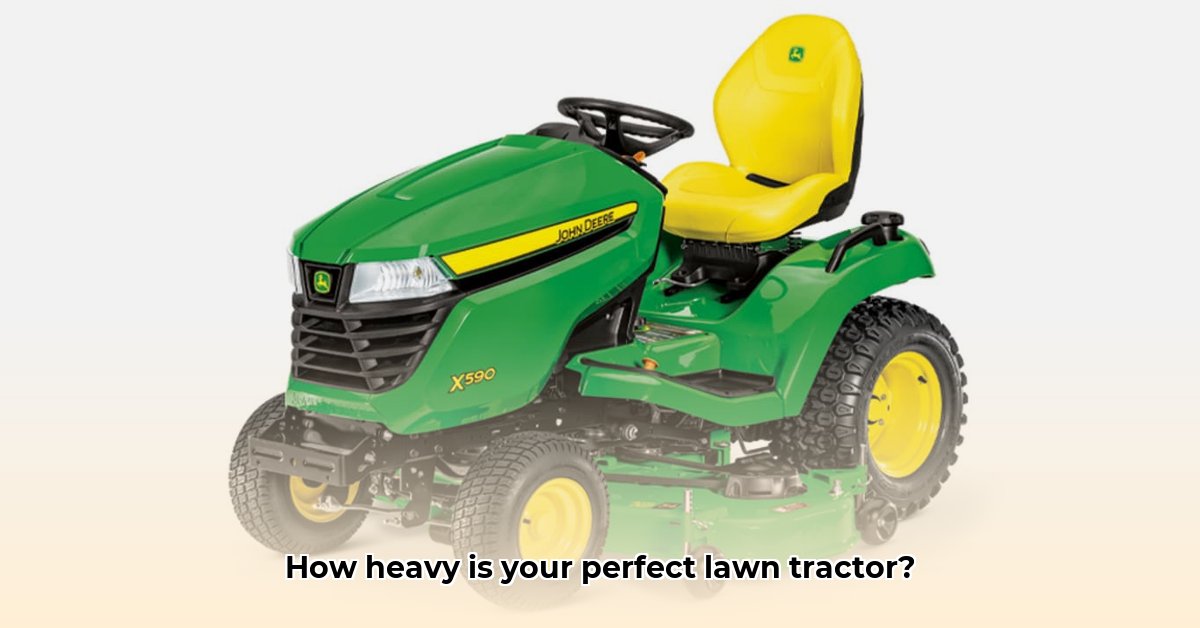
Choosing the right lawn tractor depends on many factors, but weight is surprisingly important. It directly impacts maneuverability, stability, and overall ease of use. This guide will help you determine the ideal weight for your specific needs, ensuring you get the perfect machine for your yard. For more powerful options, check out Kubota options.
Understanding Lawn Tractor Weight Classes
A lawn tractor's weight isn't just a random number; it's a key indicator of its capabilities. Different weight classes cater to different needs and lawn sizes:
Lightweight (300-500 lbs): These are perfect for smaller lawns where maneuverability is key. Think of them as the nimble sprinters of the lawn tractor world, ideal for navigating tight spaces and obstacles. Fuel efficiency is typically a benefit.
Mid-Weight (500-800 lbs): Offering a balance of power and maneuverability, these are suitable for medium-sized lawns with some terrain variations. These are the reliable family sedans of the lawn tractor world – good for most jobs.
Heavy-Duty (800-1200+ lbs): Built for larger properties and challenging terrain, these provide excellent stability on slopes and uneven ground. They are the workhorses, built for serious mowing.
Factors Affecting Lawn Tractor Weight
Several factors contribute to a lawn tractor's weight:
Engine Size: Larger engines provide more power but add considerable weight.
Cutting Deck Size: Wider decks are more efficient but also heavier.
Added Features: Attachments like grass catchers or snow blowers significantly increase the overall weight.
Choosing the Right Weight for Your Yard
Selecting the appropriate weight class involves considering several factors:
Yard Size: Small yards (< 1/2 acre) benefit from lightweight mowers, while large yards (> 1 acre) require the power and stability of heavier models. Medium-sized yards (1/2 - 1 acre) are well-suited to mid-weight tractors.
Terrain: Uneven or hilly terrain requires a heavier, more stable tractor to prevent tipping. Flat, smooth yards allow for more maneuverable, lighter models.
Features: Consider necessary attachments. Each added feature – grass catcher, snowblower, etc. – adds weight.
Storage: Ensure you have adequate storage space for the chosen tractor.
Weight and Safety: A Critical Consideration
The weight of your lawn tractor directly impacts safety. A mower that's too light might tip on a slope; one that's too heavy may be difficult to control. Always prioritize safety and consult your owner's manual for detailed instructions. Remember, a safe and controlled operation increases efficiency and reduces the risk of accidents.
Comparing Lawn Tractor Weights Across Brands
Finding precise weight information can be challenging. Manufacturer websites may not always provide this data. To compare effectively:
Manufacturer Websites: Start with manufacturer specifications, but remember inconsistencies can occur.
Online Retailers: Many retailers include weight specifics in product descriptions. Comparing across retailers provides a more comprehensive picture.
Customer Reviews: Reviews occasionally mention weight, providing valuable anecdotal evidence. Be cautious; individual experiences vary greatly.
Direct Comparison: Compare similar models within the same weight class for a meaningful analysis.
Account for Added Features: Always factor in the additional weight of attachments when comparing different models.
Summarizing Your Options: A Quick Reference Guide
| Lawn Size | Suggested Weight Range (lbs) | Tractor Type | Key Considerations |
|---|---|---|---|
| Small (< 1/2 acre) | 300-500 | Lightweight | Maneuverability and ease of use |
| Medium (1/2 - 1 acre) | 500-800 | Mid-weight | Balance of power and maneuverability |
| Large (> 1 acre) | 800-1200+ | Heavy-duty | Power, stability, and performance in tough conditions |
Ultimately, the ideal lawn tractor weight depends on your specific needs and preferences. By carefully considering the factors outlined above, you can choose a model that perfectly matches your yard size and terrain, enhancing your mowing experience for years to come. Remember to research specific models and compare specifications before making a purchase decision.